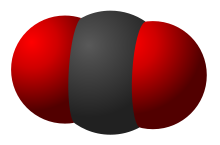Triatomic molecule

Triatomic molecules are molecules composed of three atoms, of either the same or different chemical elements. Examples include H2O, CO2 (pictured), HCN, O3 (ozone) and NO2.
Molecular vibrations
[edit]The vibrational modes of a triatomic molecule can be determined in specific cases.
Symmetric linear molecules
[edit]A symmetric linear molecule ABA can perform:
- Antisymmetric longitudinal vibrations with frequency
- Symmetric longitudinal vibrations with frequency
- Symmetric transversal vibrations with frequency
In the previous formulas, M is the total mass of the molecule, mA and mB are the masses of the elements A and B, k1 and k2 are the spring constants of the molecule along its axis and perpendicular to it.
Types
[edit]Homonuclear
[edit]

Homonuclear triatomic molecules contain three of the same kind of atom. That molecule will be an allotrope of that element.
Ozone, O3 is an example of a triatomic molecule with all atoms the same. Triatomic hydrogen, H3, is unstable and breaks up spontaneously. H3+, the trihydrogen cation is stable by itself and is symmetric. 4He3, the helium trimer is only weakly bound by van der Waals force and is in an Efimov state.[1] Trisulfur (S3) is analogous to ozone.
Geometry
[edit]All triatomic molecules may be classified as possessing either a linear, bent, or cyclic geometry.[further explanation needed]
Linear
[edit]Linear triatomic molecules owe their geometry to their sp or sp3d hybridised central atoms. Well-known linear triatomic molecules include carbon dioxide (CO2) and hydrogen cyanide (HCN).
Xenon difluoride (XeF2) is one of the rare examples of a linear triatomic molecule possessing non-bonded pairs of electrons on the central atom.
Bent
[edit]Cyclic
[edit]References
[edit]- ^ Kunitski, M.; Zeller, S.; Voigtsberger, J.; Kalinin, A.; Schmidt, L. P. H.; Schoffler, M.; Czasch, A.; Schollkopf, W.; Grisenti, R. E.; Jahnke, T.; Blume, D.; Dorner, R. (30 April 2015). "Observation of the Efimov state of the helium trimer". Science. 348 (6234): 551–555. arXiv:1512.02036. Bibcode:2015Sci...348..551K. doi:10.1126/science.aaa5601. PMID 25931554. S2CID 102090236.
External links
[edit] Media related to Triatomic molecules at Wikimedia Commons
Media related to Triatomic molecules at Wikimedia Commons




